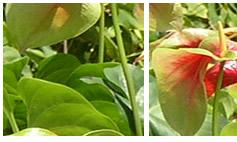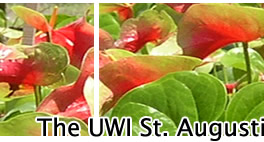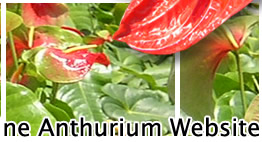 |
 |
||||
 |
 |
 |
|||
|
|
Infrastructure ctd. The type of crop is self-explanatory. Anthuriums may not be the only crop that will be grown. Perhaps other ornamentals such as orchids or heliconias, or gingers of even supporting foliage plants may be required for production. All these have direct implications on the design, management and even location of the greenhouse. Careful thought is required when mixed productions systems are developed as resources can be wasted in infrastructure that may have to be altered later on. Another consideration would be the stage of production in which a grower may be involved. There can be the nursery or seedling stage which requires more shade, water / humidity control and greater management skills for hardening plants out of tissue culture or it may be growing from seedling to flowering size or all the stages. This too has implications on design, location and management of a greenhouse. This refers to the slope of the land. The ideal is gently sloping at 2-10 degrees, however this should not hinder those who wish to set up green houses on steeper slopes but it becomes an expensive venture, as it requires extensive civil works. These works may include excavation of the hillsides to create terraces, foundation walls and other soil stabilization works. Thought into dealing with drainage runoff is also of importance since the threat of land erosion from moving water increases with increasing slope. Incorporation of designs to slow the runoff such as eyebrow drains or fixed concrete or invert drains running parallel to the slope are invaluable in maintaining the integrity of the land. One advantage of setting up on sloping land is that differences in height can allow the use of gravity to provide the energy to for irrigation especially if it is drip irrigation. Location to Markets / Suppliers Close location to markets or to the point of delivery is advantageous to the owner / operator as it impacts on reduced costs for freight as well as reducing postharvest losses. Reduced costs can also be attained if the operation is close to existing input suppliers especially if plant material, media and other consumables have to be obtained via shipping. Savings can also be made if the location to other similar nurseries or establishments especially if associations and co-operatives are formed as this can lead to negotiated or shared costs. However, a major concern can be the increase pest and disease pressure if the same or similar operations are densely located together. In such a situation it may very well be wise to explore the feasibility of screening the structures. This is a very critical factor as most greenhouse systems require electricity to power pumps, motors and to provide light. Fortunately in the tropics we do not require electricity for heat. However, some greenhouse installations require energy for cooling especially those designs that are gutter connected or continuous over 20 meters and / or have low overhead height. The two sources of electricity can be from the power company or from a generator. As with the previous considerations the cost of any of the two alternatives should be analysed. For example, it may be cheaper to purchase and operate a generator if there is a greater costs associated in running electrical supply line along an access road of 5 kilometers (assumption) from the nearest power connection. The site suitability based on the size of the operation to cover the operating cost of the generator as well as to bring a satisfactory return on the investment. If the answer is yes to the latter, then by all means continue. However, if after the analysis the answer is no, then an alternative site with lower capital investment and / or operating cost should be sought.
The term environmental condition refers to the climatic conditions found on the site where the greenhouse is to be set up. This consists of rainfall, temperature, daylight and humidity. These climatic conditions can impact directly on the layout, design and materials used in greenhouse structures. For example operations that are located from Grenada south to the equator (Trinidad, Guyana, Suriname) have greater annual rainfall than the islands north of Grenada owing to the effect of the Inter-Tropical Convergence Zone. In such areas it may very well make financial sense to control water from rainfall by using transparent UV plastic. The cost benefit would be obtained from the reduce labour and use of chemicals in managing disease. There is an observed correlation between the increase incidences of bacterial disease in anthurium in the rainy season (July – December). Climatic information can be readily obtained from Meteorological stations. However, this may not reflect the true climatic conditions at the place of operation (microclimates). Night temperatures are sometimes lower in valley than those in the plains due to temperature inversion. This may predispose plants and flowers to a higher incidence of disease. Increase productivity can be obtained from increasing light hours by situating a greenhouse in open flat land as oppose to a valley with high hill sides. The islands of the Caribbean with the possible exception of Trinidad and Tobago and southern United States are prone to strong tropical storms and Hurricanes. Associated with these tropical storms are high winds and torrential rains which can also lead to flooding. Most greenhouses are built with these concerns in mind. Larger posts, additional bracing, deeper foundations are often advantageous. It is strongly recommended based on greenhouses that have survived hurricanes that shade cloth and / or plastic be removed altogether or at least from the sides so as to allow the wind to blow through with minimal resistance from the structure. It is labour intensive or even time consuming to remove all shade cloth and plastic. The main drawback being that one has to rush to put back on after the storm has gone as you may lose you entire crop to sun burn. One nursery operation survived with sides and top covering intact because there were fruit trees planted around the sides, which acted as a wind break. Fortunately the structure was not damaged from broken or fallen trees as they were planted some distance away.
|
© 2004 - The University of The West Indies. All rights reserved. Disclaimer | Privacy Statement Telephone: (868) 662-2002 Fax: (868) 663-9684 |
|